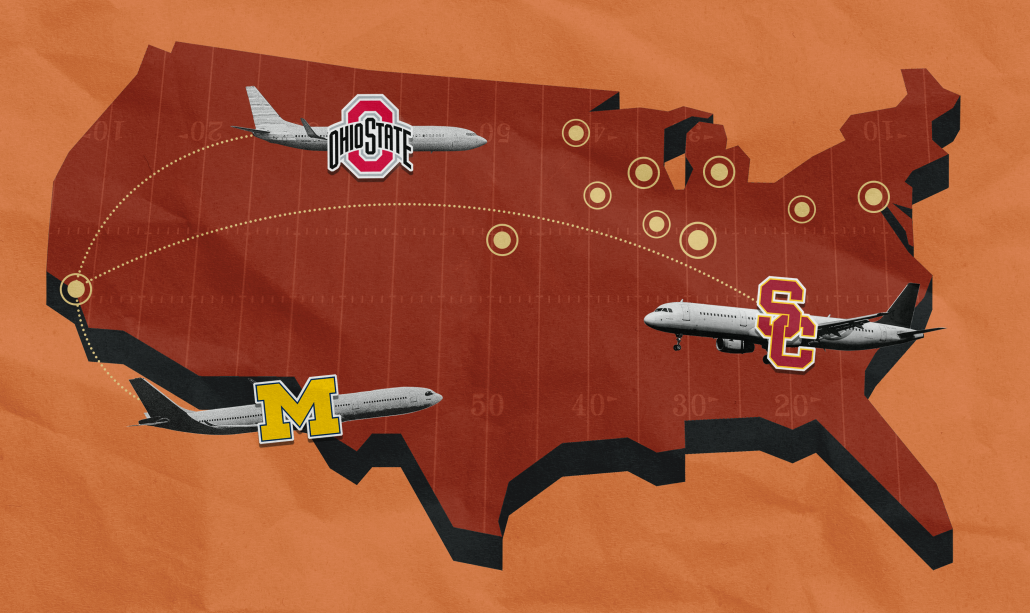USC alters college football landscape with move to Big Ten

In the summer of 2021, Texas and Oklahoma suddenly revealed that they will be leaving the Big 12 to move to the Southeastern Conference. This summer, USC and their cross-town rivals UCLA decided to make a similar move, this time to the Big Ten.
As members of the original Pacific Coast Conference which later became the Pac-12, USC and UCLA have significant history. To many, it was stunning to see the universities leave a West coast-based conference with which they have a strong relationship for a conference concentrated in the Midwest.
However, as the college athletics landscape is dynamically changing with both the SEC and Big 12 expanding, it is clear that USC wanted to be part of the action by joining the Big Ten so that its national presence can continue to grow.
It appears that USC had been thinking about this move for a while in the past year. After the Texas and Oklahoma announcement, the new Pac-12 Commissioner George Kliavkoff was listening to Big 12 schools who were thinking of joining the Pac-12. So, he held a call with three presidents and three athletic directors from the Pac-12, including USC President Carol Folt. In this meeting, they were to deliberate on which Big 12 teams to potentially add to the conference.
Within about 15 minutes of the presentation, Folt ended the discussion on Pac-12 expansion.
“Carol [Folt] shut it down,” a source said to the Los Angeles Times about Folt’s involvement in this expansion call. “She [Folt] cooled the whole process,” according to another source from the same article.
Expanding the conference would mean less revenue per school until the new media contract and USC did not want to stay for that long, especially with the conference’s recent struggles in TV viewership and on-field performance.
For UCLA, the move was easier to understand. At the start of this year, their athletics department was $62.5 million in debt, so they needed an infusion of cash. Right now, the new Big Ten media deal is expected to pay each member school nearly $100 million per year. Depending on whether the Big Ten can also secure major revenue-building schools like USC’s rival Notre Dame, this value could potentially increase.
With many Pac-12 games happening later in the day for Eastern and Central Standard Time viewers, these schools are not receiving as much viewership compared to other Power 5 conferences in the country. For example, the ratings for the 2021 Pac-12 football championship game between Utah and Oregon had a mere 4.2 million viewers. On the other hand, the Big Ten’s championship game that year between Michigan and Iowa had 11.7 million viewers, the third highest in college football for the 2021 season.
Finally, although USC and UCLA are among prestigious schools such as Stanford and Cal in the Pac-12, the Big Ten provides additional academic benefits as well. Aside from Nebraska, all of their members are part of the Association of American Universities (AAU) which includes the strongest research universities in the country. Moreover, the Big Ten Academic Alliance fosters research collaboration among its schools which strengthens USC and UCLA’s prestige.
Therefore, from the financial, viewership and academic standpoints, it makes sense for both schools to make the move even though it may be complicated geographically.
Overall, reactions to the decision have been mixed.
“The Pac-12 had to have seen this coming, despite George Kliavkoff’s efforts to connect with USC AD Mike Bohn and sell his vision for football,” said Brady McCollough, a college sports reporter at the Los Angeles Times. “In the NIL era –– and eventually, the pay for play era — the Trojans wouldn’t be able to compete without tons more media rights revenue.”
“Just got off the phone with someone who believes this eventually leads to two megaconferences — the Big Ten and SEC — with 20 or more members apiece,” said Nicole Auerbach, a senior writer at The Athletic.
There were more comedic remarks on Twitter as well.
“UCLA at Iowa in November during a driving snowstorm at 11 a.m. CT is just what college football was missing,” said the RedditCFB account. “Sources tell us that the thing that really made up USC/UCLA’s minds was the fact that Ohio State actually got a trademark on the word ‘the’.”
During the Pac-12 Football Media Day last month, Commissioner George Kliavkoff expressed dismay at the departure but still recognized the importance of both schools to Pac-12 history.
“As a conference, we are of course very disappointed by the decisions by USC and UCLA to leave the Pac-12 and a century of tradition and rivalries after 2024,” said Kliavkoff. “That said, USC and UCLA have been proud members of the Pac-12 for almost a century. Despite their decision, we cherish our relationship with their student-athletes, coaches, staff, faculty, alumni and fans.”
Even though there are a couple of years until the move and UCLA, as a state school, is facing potential challenges from Governor Gavin Newsom and the UC Board of Regents, this move is immense for both schools and will shift the college football landscape.
Kliavkoff recently re-emphasized his disdain for the decision, telling The Athletic that “It’s clear that USC and UCLA made a decision for short-term financial gain at the expense of their student-athletes … I think they will regret it more as time goes on.”
The Pac-12 has been exploring options of expansion and could partner with the Atlantic Coast Conference or welcome schools such as SMU or San Diego State to replace its former Los Angeles universities.

